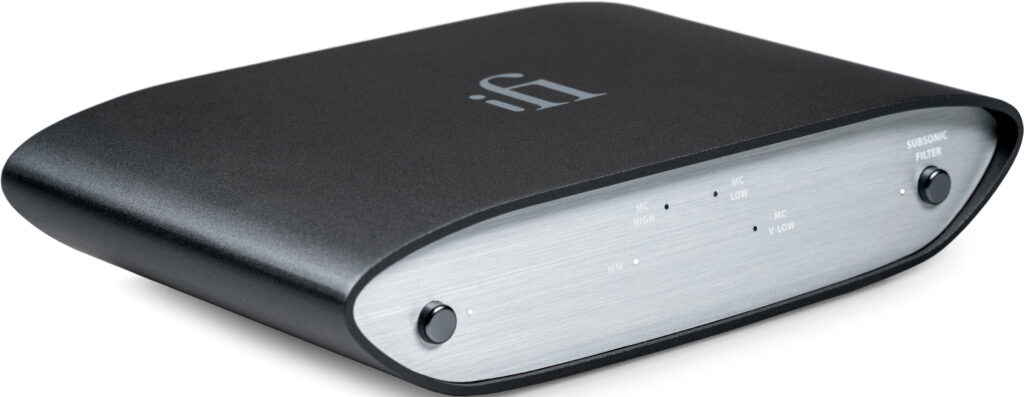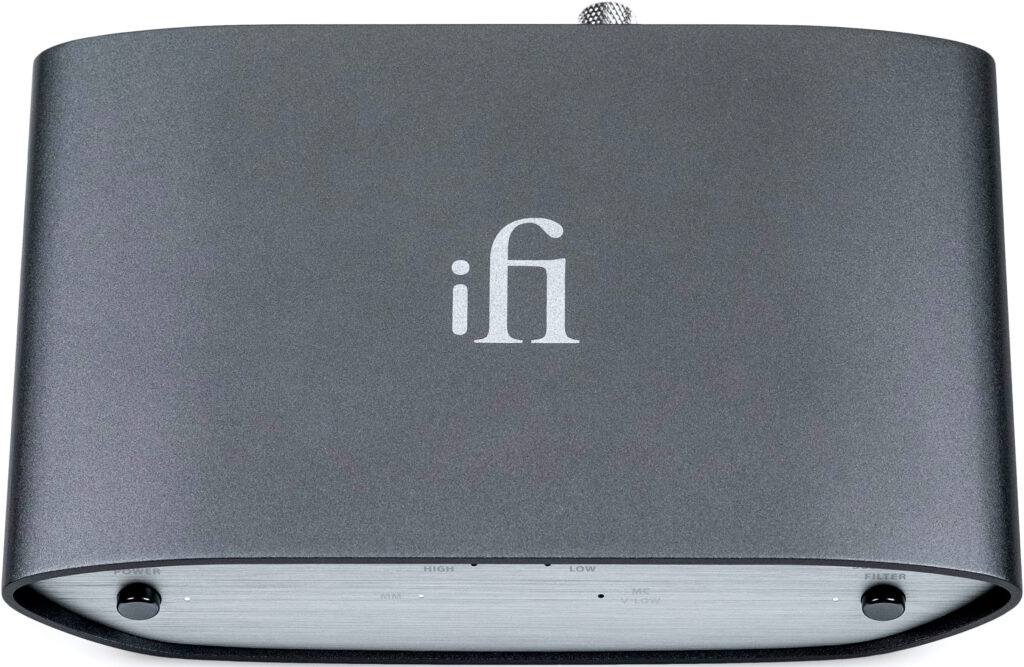It is critical that a phono stage introduce as little noise as possible to the listening experience. When I turned on the ZEN, it was so quiet that I could not tell it was on until I started playing records. A number of inexpensive phono stages seem to have noise problems, although neither my NAD nor the iFi ZEN have this problem.
Switching to my Goldring turntable with the Talisman low output moving coil cartridge allowed me to listen to how quiet the iFi ZEN could be with a really small signal. This one feature would make or break a phono stage with low output moving coil capabilities because any noise would be greatly amplified. I tried all four settings, including the moving magnet setting. The instruction manual was a little deficient on direction, so I recommend experimenting with the different settings. I was surprised that even the moving magnet setting could amplify the .22mv output to a fairly pleasant listening level. As I mentioned before, my Antique Sound Lab line stage has a lot of gain, so I settled on the second setting, which is normally used for high output moving coil cartridges. This had the most natural sound.
The iFi ZEN really shined using my Talisman. The ability to amplify the low to very low output from any moving coil phono cartridge without any additional noise is a strength of the ZEN. The fact that there was no background noise even with this small signal is a major plus and let the strengths of my Talisman really shine. The ZEN combined with my Goldring turntable and Talisman cartridge really improved upon the sound of my 27 year old NAD preamplifier’s very good phono stage, probably due to the multiple gain settings allowing you to optimize the sound. My NAD does not amplify the signal enough. I do not use my Talisman with my tube components very often, so I was really enjoying the music. Right now I have the Steely Dan album Aja playing.
The Talisman phono cartridges were my favorite cartridges for years until I started using the Grado Platinum and the Hana EH. The sound I got from my Talisman through the ZEN phono stage made me understand why I still use this 28 year old phono cartridge. The clarity of the Talisman along with its rich sound are the primary strengths of this classic cartridge. The extra gain from the ZEN may have been a factor. The only drawback is the bass is a little light, which is the biggest weakness of the Talisman line of phono cartridges. However, the Zen allowed all of the strengths of this low output moving coil to come through. This means that if you enjoy the sound of a low output moving coil cartridge you do not need to spend an exorbitant amount of money on a phono stage. This little unit can bring out that richness in sound from most quality phono cartridges, including the many low output moving coil cartridges.
Many people feel that if a moving coil phono cartridge is offered in a choice of low- and high-output models, as many are, the low output version is better than the high output version. I am not sure if the Hana EL low output version is better than my high output Hana EH because I really like the Hana EH. You now have the ability to choose. One thing I did learn was that the ZEN was good enough to help me decide that I preferred my high output Hana EH to my low output Talisman after my first direct comparison. Both phono cartridges had that musical richness that separates the better cartridges from the inexpensive ones. Granted the AR turntable is a much better turntable than the Goldring, however, I was easily able to hear the differences between the cartridges. I did enjoy both cartridges played through the ZEN and could be very happy with either one as my primary cartridge.
I also connected both turntables to my Wyred4Sound mINT integrated amplifier while continuing to use my Alon speakers. A number of music lovers would probably be using a similar amplifier with the iFi ZEN. When combining the Goldring/Talisman with the mINT, I switched to the third setting because the mINT has a much lower gain. This optimized the sound. The flexibility of increasing the moving coil setting to a higher gain is really an asset of the ZEN. One observation when I was using the iFi ZEN, when switching between the different cartridge settings, it sometimes did not switch. Turning the unit off and then switching the gain, then turning it back on solved this problem. The ZEN also takes a few seconds to stabilize after it is initially turned on. I left the ZEN turned on all of the time as I do with my NAD PP-1.
The mINT is a great little integrated amplifier and I continue to get from it that wonderful imaging and soundstage that is normally reserved for tube equipment. The bass increased a little probably due to the 100 watts of power provided by the mINT. The midrange and highs were still pleasing. The ZEN’s lack of noise no matter what setting (1 to 4) makes this unit a worthy addition for any person wanting to get into vinyl. This adjustable features means that the ZEN would go well with most turntables, cartridges, amplifiers, and speakers. Although I prefer the tube line stage and tube power amplifiers, this is still a very enjoyable experience. When switching components, it seems going from tube to solid state had a more dramatic effect than switching phono stages. The fact that the ZEN was neutral enough to allow me to notice the difference gives you an idea of how good it is.
After my extensive listening, I found the ZEN made a much bigger difference with my low output moving coil phono cartridge. It seems the ability to adjust the settings really helps me optimize the sound. My secondary Goldring turntable with the Talisman low output phono cartridge combination really went to another level. This relatively modest setup has a nice warm sound that most people could listen to for hours without any listener fatigue. Overall this was a more euphonic as opposed to analytical sound, which, for me, makes it well suited for listening to classical music. Don’t get me wrong, the ZEN sounds great with jazz and rock also, so long as you don’t need any extra zip.
Going back to my AR turntable ensemble combined with the Wyred4Sound mINT gave me an outstanding sound that had me wanting to just sit back and listen instead of finishing writing this review. Again, just like with the Goldring turntable, I preferred the tube magic. This is still a very good setup and you don’t have to go to the trouble of buying tubes with a solid state amplifier. The difference is so subtle that the majority of listeners would be perfectly happy with the iFi ZEN and a quality solid state integrated amplifier. Maybe one day I will get tired of playing around with my tube equipment and turn to the simplicity of solid state.
It is too bad I had already returned the Pro-Ject X1 turntable because it combined with the iFi ZEN phono stage would have been a nice combination. Adding either the Magnepan LRS speakers or the Martin Logan 60XTi along with the Wyred4Sound mINT or a comparable integrated amplifier would give you a true high-end turntable system spending from $4,000 to $6,000. This seems like a lot, but compared to other tech products that become obsolete after a couple of years, this system can give you a lifetime of happiness, making the cost per year minimal. As I stated in my initial comments, I tend to keep components for a very long time. Even all of my newer tube equipment is over 12 years old.
It was difficult comparing the iFi ZEN phono stage to my other phono stages because by the time I disconnect and reconnect the different components my short-term memory has difficulty with the subtle differences between the various units. This is the opposite of comparing phono cartridges, where even similar priced cartridges sound drastically different. That being said, I still felt the ZEN had better resolution and really worked well with my various phono cartridges, especially my Talisman low output moving coil phono cartridge. I thoroughly enjoyed listening to the ZEN and would be interested in checking out some of iFi’s other products. Some audiophiles may eliminate the ZEN because they feel a product this inexpensive can’t be good enough for their high priced analog system. My feeling is that this phono stage would integrate nicely with the majority of high-end record playing systems. There are now a number of affordable phono stages in the $150 range out there and the majority of listeners would not have to spend more to have a thoroughly enjoyable vinyl experience, so there is no reason to not play records. I would use the savings from a more expensive phono stage to either buy a better phono cartridge or more records.
My NAD PP-1 cost $129 in 1998, which adjusted for inflation would be about $200 today. The iFi ZEN cost $149, while also including a low output moving coil stage with three different settings. The fact that the resolution is better makes this an outstanding bargain. All iFi products are widely available making purchasing this unit a breeze. This is my new favorite phono stage in the $150 price category, so I have decided to purchase the iFi ZEN review sample as an early Christmas present.
Copy editor: Dan Rubin
- ← Previous page
- (Page 2 of 2)




Hi
Which power supply did you use with the phono? IFI has a base power supply and upgraded units.
Thanks,
John
The stock power supply that came with the unit.
I think your review is spot on. I have a couple of question with regards to it’s (ifi zen phono) performance, musicality wise, although you’ve mentioned it’s top end is musical. What about it’s overall musicality from top to bottom, do you feel that this unit is musically involving? What about it’s phase & rhythm, are you getting those too? Also the speed, is it fast enough to get you trilled, like thunderous attact & so forth?
The iFi ZEN had a warm musical sound as opposed to an analytical sound which I personally think was a result of the phono cartridges that I used rather than the phono stage. The ZEN is very quiet and does get out of the way of the music. This was evident when the ZEN was combined with my Talisman low output moving coil phono cartridge. The characteristics you desire may be better achieved using a different phono cartridge as opposed to the iFi ZEN.
Thank you Byron. We have the same cartridge – the Hana EH as well which serve my needs. The reason I asked those question is because one reviewer gave it a 4 star. He said something about the phase & rhythm that is lacking thereby, to his ears, not musical enough. In my observation, I certainly, didn’t noticed anything like that. What I heard was rhythmic, fast and musically involving, describing the music as the artist intended for us (listener) to be heard. I also noticed, zen preamp has really good weight, macro & micro dynamics presence as well, especially playing classical music. What gets me the most is its speed & weight for such a small phono preamp, not to mention its overall performance for such a low price as well. I didn’t have a tube amp but my preamp is tube & solid state hybrid. Thanks again for spot on review.